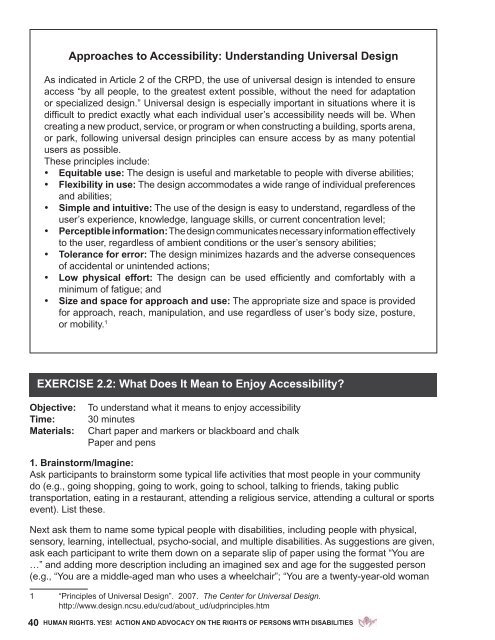Full page photo print - Harvard Law School Project on Disability
Full page photo print - Harvard Law School Project on Disability
Full page photo print - Harvard Law School Project on Disability
You also want an ePaper? Increase the reach of your titles
YUMPU automatically turns print PDFs into web optimized ePapers that Google loves.
Approaches to Accessibility: understanding universal design<br />
As indicated in Article 2 of the CRPD, the use of universal design is intended to ensure<br />
access “by all people, to the greatest extent possible, without the need for adaptati<strong>on</strong><br />
or specialized design .” Universal design is especially important in situati<strong>on</strong>s where it is<br />
difficult to predict exactly what each individual user’s accessibility needs will be. When<br />
creating a new product, service, or program or when c<strong>on</strong>structing a building, sports arena,<br />
or park, following universal design principles can ensure access by as many potential<br />
users as possible .<br />
These principles include:<br />
• equitable use: The design is useful and marketable to people with diverse abilities;<br />
• flexibility in use: The design accommodates a wide range of individual preferences<br />
and abilities;<br />
• simple and intuitive: The use of the design is easy to understand, regardless of the<br />
user’s experience, knowledge, language skills, or current c<strong>on</strong>centrati<strong>on</strong> level;<br />
• Perceptible informati<strong>on</strong>: The design communicates necessary informati<strong>on</strong> effectively<br />
to the user, regardless of ambient c<strong>on</strong>diti<strong>on</strong>s or the user’s sensory abilities;<br />
• Tolerance for error: The design minimizes hazards and the adverse c<strong>on</strong>sequences<br />
of accidental or unintended acti<strong>on</strong>s;<br />
• low physical effort: The design can be used efficiently and comfortably with a<br />
minimum of fatigue; and<br />
• size and space for approach and use: The appropriate size and space is provided<br />
for approach, reach, manipulati<strong>on</strong>, and use regardless of user’s body size, posture,<br />
or mobility . 1<br />
eXeRcise 2.2: what does it mean to enjoy Accessibility?<br />
objective: To understand what it means to enjoy accessibility<br />
Time: 30 minutes<br />
materials: Chart paper and markers or blackboard and chalk<br />
Paper and pens<br />
1. brainstorm/imagine:<br />
Ask participants to brainstorm some typical life activities that most people in your community<br />
do (e .g ., going shopping, going to work, going to school, talking to friends, taking public<br />
transportati<strong>on</strong>, eating in a restaurant, attending a religious service, attending a cultural or sports<br />
event) . List these .<br />
Next ask them to name some typical people with disabilities, including people with physical,<br />
sensory, learning, intellectual, psycho-social, and multiple disabilities . As suggesti<strong>on</strong>s are given,<br />
ask each participant to write them down <strong>on</strong> a separate slip of paper using the format “You are<br />
…” and adding more descripti<strong>on</strong> including an imagined sex and age for the suggested pers<strong>on</strong><br />
(e .g ., “You are a middle-aged man who uses a wheelchair”; “You are a twenty-year-old woman<br />
1 “Principles of Universal Design” . 2007 . The Center for Universal Design.<br />
http://www .design .ncsu .edu/cud/about_ud/udprinciples .htm<br />
40 humAn RighTs. yes! AcTi<strong>on</strong> And AdvocAcy <strong>on</strong> The RighTs of PeRs<strong>on</strong>s wiTh disAbiliTies




